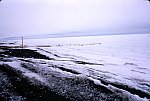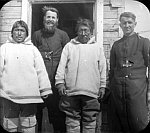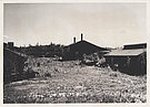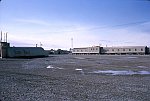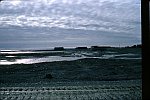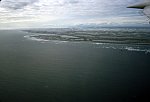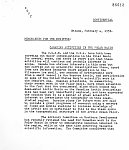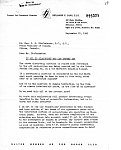Government Policy and the Canadian North
Author: Curt McManus Page 1 | Page 2 | Page 3
By the end of 1898, the Gold Rush had spent itself. The sovereignty pressures of the rush eased, prospectors mined barren claims, and many men and women pulled up stakes and headed off to the next rush in Nome, Alaska. Not everyone went, however, much to the likely consternation of the federal government. Those people who remained in the Yukon had established themselves on Canadian soil and so the government could no longer avoid its responsibilities. The Yukon became a territory in 1898 and thereby officially came under the administrative control of the federal government. By 1908 the territory even had an M.P.
The North West Territories followed a slightly different path. Believing that the most valuable resources of the North had already been mined, federal authorities instead prepared themselves for the future in the central and eastern regions of the arctic. Treaty 8 was signed with the Dene of the Mackenzie River basin in 1899, in anticipation of further resource development in that area. No treaty was signed with Yukon natives and this was a good example of what Ken Coates called the policy of letting Indians be Indians in the Canadian north. The resources had already been tapped, went the thinking, so why bother with a treaty?
Sovereignty again played the chief role in the federal government’s next intervention in the north in 1903. Herschel Island was a tiny whaling community located on the edge of the Arctic Ocean in north-west Yukon right next door to Alaska. Historian Ken Coates notes that it had the reputation of being “a modern day Sodom and Gomorrah.” Anthropologist Diamond Jenness called it” a hive of debauchery.” Missionaries, once again, called on the government to intervene and restore order to this remote outpost because the moral fiber of its inhabitants was being attacked by the three sins of drunkenness, gambling and loose women. And once again the government did not intervene until matters related to sovereignty came into play. It seems there was non-Canadian whaling occurring in Canadian waters. One lone Mountie, Sgt. F.J. Fitzgerald, was sent north to investigate. And while the matter had blown over by the time he arrived with the approaching slump of the whaling industry, the essential point remains that the government once again had to be encouraged to assert authority over its northern lands.
With few exceptions, the Canadian government simply had no policy for the Canadian North up to 1905. It had involved itself in the north only after being badgered to do so, usually by missionaries who alerted federal authorities of nefarious activities, unscrupulous trading practices and threats to sovereignty. Indeed, for a considerable amount of time, police posts and the presence of missionaries were the only visible sign that a western nation had claimed rights over this vast northern land.
The period in the Canadian North between 1905 and 1945 was a period of dormancy. Historian Ken Coates called it the “doldrums” where nothing much of consequence occurred, outside the steady and isolated performance of the fur trade. There were no pressing matters of sovereignty, no missionaries asking for help in battling for the souls of natives, no Yankee intrusions. But it was a time when the government took the first small steps toward establishing and expanding on its presence in the north. Residential Schools, for example, began appearing shortly after the turn of the century and by the mid 1920’s four of these facilities operated in the North West Territories.
The Canadian government also continued its explorations in the north; eastern arctic patrols were resumed in 1922; and police posts were expanded. The presence of Canada in the north was unmistakable if minimal. But in the words of Ken Coates the fact remained that “the government and the people of Canada could see no [role] for the distant and frozen northland.” It took the Second World War and the Cold War to finally draw the eyes of the government and the nation toward that vast and enormous region of the country which until that time had escaped notice. The north, it was believed, was a weak spot through which foreign enemies could attack and it was this belief which dramatically transformed the north.
By the time John G. Diefenbaker assumed office in 1957, the North was pock-marked with signs of its new found importance. The Alaska Highway had been built during the Second World War; the CANOL pipeline had been developed (though it was abandoned shortly after), airfields had been constructed at many northern points including Frobisher Bay, Fort Chimo and Coral Harbor and the Distant Early Warning system had been developed.
The D.E.W. line was the most ambitious of these northern defense projects. It was a system of 58 radar stations strung out along the length of the arctic from Alaska to Baffin Island to warn against missile attack. Sadly out of date shortly after they were built, the D.E.W. line was mothballed and adopted as a training facility. Perhaps the D.E.W. line could also be seen as a caution against developing too fast and too quickly in the north.
This confidential memo written for John G. Diefenbaker illustrates why the north was important, and it further explains why the Diefenbaker government placed northern development so high on its list of priorities. This memo, in fact, is the likely reason why almost one year later the Minister of Mines in the Diefenbaker administration announced a major expedition to the Arctic Continental Shelf. While Paul Comtois leaves out any mention of the threat the Cold War represents to Canada, he does say the expedition “will be a major step toward securing detailed information about this important areas.”
Whether the Cold War is what prompted the Diefenbaker government to focus on the North is a question open for debate; the conflict certainly provided a not inconsiderable impetus for action. But whatever the answer, resource development and the Cold War dovetailed nicely at the policy level and so in some ways the two elements became inseparable in the minds of politicians and ordinary Canadians. On the one side, there were those like Benjamin Lang who warned against developing the North because Canada had no way to defend any interests it might develop in that region.
Others like Watson Lake Doctor W.C. Prowse (brother to a prominent Liberal party member) argued that continued neglect of the north would invite invasion. Prowse also points out that it was the bureaucrats themselves who stood in the way of northern development. In his long litany of wrongs and personal injustices mentioned in this letter, Prowse singles out government officials for scorn calling them “lazy and utterly visionless.”
But, Cold War or not, Diefenbaker committed his administration to northern development and he did so almost self-consciously and with an eye on Canadian history and his place in it. While refraining from drawing direct personal parallels between himself and Canada’s first Prime Minister, the nation-building Sir John A. Macdonald, Diefenbaker saw similarities between his program of northern development and Macdonald’s programs of national development. Where Macdonald had his National Policy, Diefenbaker had his New National Policy; Macdonald developed the west, Difenbaker wanted to develop the north; Macdonald had the nickname, “the Chieftain” and Diefenbaker’s moniker was the “Chief.”

